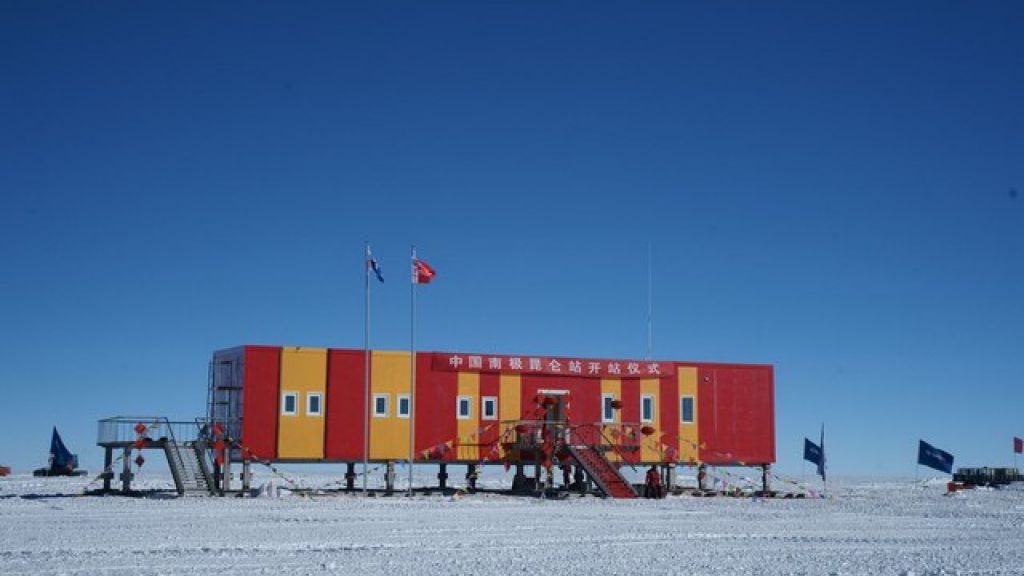China’s research programmes at Kunlun Station
Kunlun Station at Dome A, East Antarctica
© PRIC
China has been very proactive in increasing its polar research capacity in recent years. Already active in Antarctic research for three decades, China seized the opportunity of International Polar Year (IPY) 2007-08 to set out on an ambitious new multiyear programme of infrastructure building and scientific research in the Polar Regions.
Extensively covered on SciencePoles at the time, this first article in a two-part series looks at some of the scientific achievements in the three years since the IPY ended as well as some of the ambitious scientific research projects in the works at China's new Kunlun Station on top of the East Antarctic Ice Sheet.
Kunlun Station: an ideal place to observe the stars
China’s flagship project during the IPY was the January 2009 construction and inauguration of Kunlun Station. Located at Dome A (the summit of the East Antarctic Ice Sheet, at an altitude of 4,093 metres), Kunlun currently comprises some 250 m2 of living and working space. The station can accommodate up to 25 research and logistics personnel. Due to its isolation, reaching the station requires a two to three-week overland journey in tracked vehicles from Zhongshan Station 1,280 km north along the East Antarctic coastline.
Since its inauguration, Kunlun has been occupied for a couple of weeks each January at the height of the Antarctic summer, when temperatures rise to a tolerable -40˚C. Although brief, these visits have been fruitful in laying the foundations for and maintaining an ambitious programme of astronomical research, meteorological observation, radar sounding, and ice coring.
In January 2009, astronomers from the Chinese Centre for Antarctic Astronomy (CCAA), working in collaboration with the University of New South Wales, the California Institute of Technology, and the University of Arizona, set up at Kunlun Station a provisional remotely operated observatory called PLATO. Its purpose is to measure and test different parameters (turbulent layer of the lower atmosphere, light emission from the moon and auroras, cloud cover and distribution, surface stability, and background radiation levels) that could affect the quality of observations at Dome A.
PLATO’s instruments include the Chinese Small Telescope Array (CSTAR). Made up of four 14.5 cm optical telescopes, this telescope array is the first of its kind to be deployed and tested in Antarctica – in temperatures as low as -80˚C.
The results from these tests have shown that Dome A, with its extremely thin and stable atmosphere, very dry air, absence of pollution, and low background radiation is one of the best locations on Earth for astronomical observation. The confirmation of these ideal observing conditions led in January 2012 to the installation of the first of three remotely steerable 50 cm Antarctic Survey Telescopes (AST3-1). Each is equipped with a 110 megapixel camera for recording images (the largest single-piece detector used in astronomy today). During the austral winter of 2012, AST3-1 captured 28,500 images and discovered a wide variety of stars in the Milky Way Galaxy that even NASA’s Kepler space telescope cannot observe.
Future astronomy projects at Dome A
Two more AST3 telescopes will be added to the array between late 2013 and early 2015. These will continue to test conditions at Dome A, especially in the infrared spectrum. They will also begin to actively search for supernovae and Earth-like planets that might be home to some form of alien life.
Looking beyond 2015 to 2020, Chinese astronomers hope to install a supercomputer at Kunlun Station that will enable them to analyse massive amounts of data gathered on-site. This will allow scientists to send simplified pre-processed data back to China via satellite using a simple Iridium phone.
A more ambitious plan headed by the Chinese Academy of Science’s Purple Mountain Observatory in Nanjing in collaboration with the Polar Research Institute of China (PRIC) seeks to build two much larger telescopes at a cost of about US$160 million. If the necessary funding can be secured in China’s next Five-Year plan, the first telescope to be built will be the Kunlun Dark Universe Telescope (KDUST), a 2.5 metre infrared optical telescope designed to detect and observe Earth-like planets in the Milky Way using infrared light, but at much higher resolution than the AST3 array. The second will be the Dome A Terahertz Explorer-5 (DATE5), a 5 metre telescope designed to detect light with longer wavelengths, which will allow astronomers to detect and observe nascent stars. The only other telescope coming close in capability is the U.S.’s 10 metre radio telescope at the South Pole.
Beyond 2020, the plan is to keep increasing the astronomical observation capacity of Dome A by installing a 6 to 8 metre infrared optical telescope and a 15 metre terahertz telescope. To operate these along with KDUST and DATE5, the station must be permanently manned. Plans are underway to make Kunlun a year-round station. The first step will be to install in the next few years on-site oxygen generators. Due to is high altitude, lower levels of oxygen can pose health problems for long-term inhabitants of Kunlun.
Glaciology & Ice Coring
Kunlun Station will also serve as and operational base for Chinese glaciologists on a quest to retrieve an 3,000 metre ice core containing what they hope will be ice dating back more than one million years. The purpose of the project is to better understand the watershed moment in the Earth's climate history about a million years ago, when ice ages suddenly changed their recurrence pattern from every 41,000 years to every 100,000 years.
The potential drilling site lies over the very steep Gamburtsev Mountain range, which is located beneath the ice sheet at Dome A. For this reason, Chinese glaciologists have been studying sub-surface topographical data obtained during the Antarctic Gamburtsev Province (AGAP) project (one of the IPY's flagship projects, to which China provided logistical support).
Since 2005, Chinese scientists have also been doing their own radar surveys of the sub-glacial environment – not only at Dome A, but also along the route between Zhongshan Station and Dome A. Another survey is planned during the 2012-13 season under the direction of Dr. Sun Bo, who led the first Chinese expedition to Dome A.
In preparation for drilling the 3,000 metre core, a team has constructed a new drilling workshop, dug into the ice sheet next to Kunlun Station. A 100 metre pilot tube was then installed, and in January 2012, researchers extracted a 120 metre ice core. This core was then shipped (via Zhongshan Station) to China for analysis.
Whilst much work is still required (possibly in collaboration with countries such as Australia and Japan), foundations are now in place for what constitutes the second ambitious research programme at Dome A, alongside astronomy.
China’s flagship project during the IPY was the January 2009 construction and inauguration of Kunlun Station.





